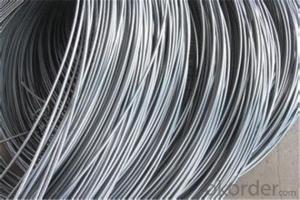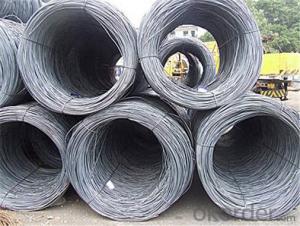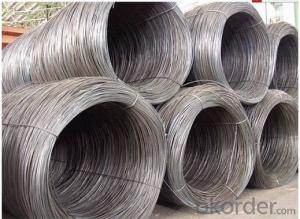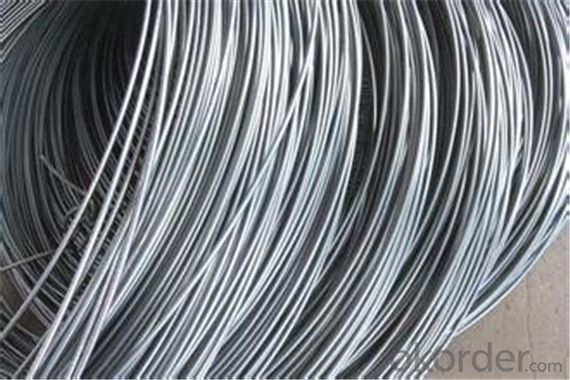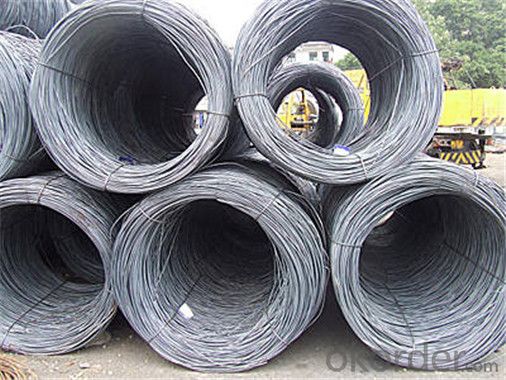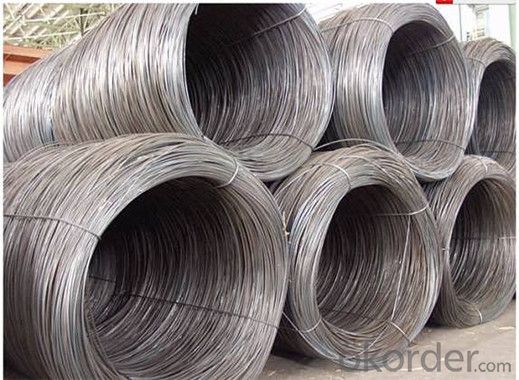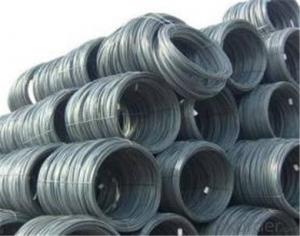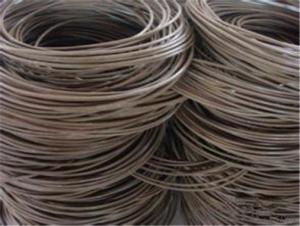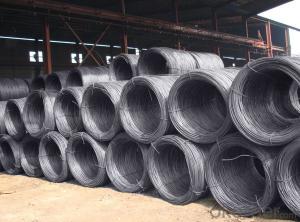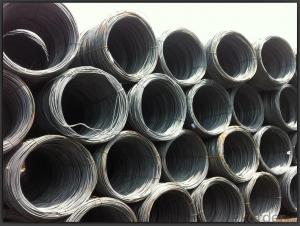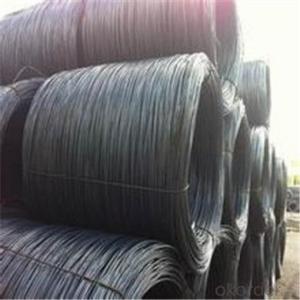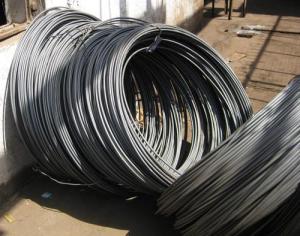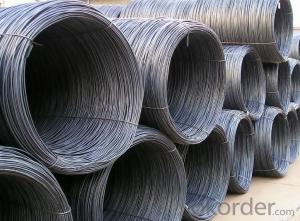SAE1006 Hot Rolled Steel Wire Rod 6.5mm with in China
- Loading Port:
- Shanghai
- Payment Terms:
- TT OR LC
- Min Order Qty:
- 500 m.t.
- Supply Capability:
- 45555555 m.t./month
OKorder Service Pledge
OKorder Financial Service
You Might Also Like
Specification
Description of wire Rod:
Our company is recognized by ISO9001:2008
1. hot rolled wire rod
2. material: Q195-235
Festures of wire Rod:
1. Drawn wire specialist, your wire rod solution
2. ISO9001 Certified Mill &SGS
3. Feature: machinability, high hardness, toughness, corrosion resistant
Specifications of wire Rod:
Product | steel wire rod |
Standard | AISI, ASTM, BS, DIN, GB, JIS |
Material/steel grade | Q195-Q235,SAE1006, SAE1008, SAE1010, SAE1018, SAE1020 or according to customers requirements |
Wire Gauge | 5.5-12mm |
Coil weight | 1.8-2.1mts |
MOQ | 25MT |
Delivery Time | 15-30 days after receipt of L/C or deposit by T/T |
Packing | In coil and load in container, if large quantity, by bulk vessel; Can be packed as customers' special requirements |
Payment terms | 1).100% irrevocable L/C at sight. |
Application | widely used in machinery parts |
Images of wire Rod:
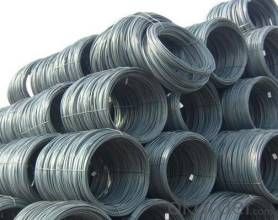
FAQ:
1. What is your package?
Packing situation: standard seaworthy packing or as customer required.
2. How long is the lead time?
Delivery time: 45 days after order confirmed.
- Q: How is steel wire rod used in the manufacturing of wire shelving?
- Steel wire rod is used in the manufacturing of wire shelving by being shaped and formed into the desired size and shape. It serves as the main structural component, providing strength and stability to the shelves. The wire rod is typically cut, bent, and welded to create the frame and supports of the shelving units, ensuring durability and the ability to hold heavy items.
- Q: How are steel wire rods used in the production of barbed wire for security fencing?
- Steel wire rods are a crucial component in the production of barbed wire for security fencing. These wire rods are used as the primary material to create the twisted and sharp barbs that provide deterrence and protection. The process begins with the steel wire rods being drawn through a series of dies, which reduces their diameter and increases their length. This process is known as wire drawing and helps to improve the strength and durability of the wire. Once the wire rods have been drawn, they are then twisted together to form a strong, continuous strand of wire. This twisted wire serves as the backbone of the barbed wire, providing stability and support. Next, the twisted wire is interwoven with sharp, pointed barbs. These barbs are created by cutting short lengths of the wire rods, sharpening the ends, and then attaching them to the twisted wire at regular intervals. The barbs are strategically placed and spaced to maximize the security and deterrent effect of the barbed wire. After the barbs have been attached, the barbed wire is typically galvanized to enhance its resistance to corrosion. The galvanization process involves coating the wire with a layer of zinc, which provides a protective barrier against rust and other environmental factors. This ensures that the barbed wire remains strong and effective in various weather conditions. Once the galvanized barbed wire has been produced, it can be wound onto spools or packaged in coils for ease of transportation and installation. The barbed wire is then ready to be installed as a security measure, typically on top of fences, walls, or other structures that require additional protection. Overall, steel wire rods play a vital role in the production of barbed wire for security fencing. They are transformed into twisted wire strands, which form the backbone of the barbed wire, and are then combined with sharp barbs to create a highly effective deterrent. The use of steel wire rods ensures that the barbed wire is strong, durable, and capable of withstanding harsh conditions, making it an essential component in security fencing systems.
- Q: How is steel wire rod used in the manufacturing of wire forms for automotive exhaust systems?
- Steel wire rod is a crucial component in the manufacturing of wire forms for automotive exhaust systems. These wire forms are used to provide structural support and stability to the exhaust system, ensuring its proper functioning and longevity. Firstly, steel wire rod is used to create the main framework of the wire form, which serves as the backbone of the exhaust system. This framework is responsible for holding and positioning various components of the exhaust system, such as the muffler, catalytic converter, and pipes. The high tensile strength and durability of steel wire rod make it an ideal choice for this application, as it can withstand the intense vibrations, heat, and pressure that the exhaust system is subjected to. Additionally, steel wire rod is used to form the hangers and brackets that secure the exhaust system to the vehicle's chassis. These hangers and brackets are essential for maintaining the proper alignment and stability of the exhaust system, preventing any unnecessary movement or rattling. The flexibility and malleability of steel wire rod allow it to be easily shaped and formed into the desired hanger or bracket design, ensuring a precise fit and reliable performance. Furthermore, steel wire rod is also utilized in the fabrication of wire mesh screens and filters that are installed within the exhaust system. These screens and filters are responsible for trapping and removing contaminants, such as particulate matter and harmful gases, from the exhaust gases before they are released into the environment. The high strength and corrosion resistance of steel wire rod make it an excellent choice for constructing these screens and filters, as they need to withstand the harsh operating conditions and exposure to corrosive elements. In summary, steel wire rod plays a crucial role in the manufacturing of wire forms for automotive exhaust systems. Its high tensile strength, durability, flexibility, and corrosion resistance make it an ideal material for creating the main framework, hangers, brackets, and screens/filters within the exhaust system. By using steel wire rod, manufacturers can ensure that the wire forms provide the necessary structural support, stability, and reliability required for proper functioning of the automotive exhaust system.
- Q: How is the quality of steel wire rod determined?
- The quality of steel wire rod is determined through various factors such as chemical composition, mechanical properties, surface condition, and dimensional accuracy. It undergoes testing and evaluation for its strength, ductility, and toughness using methods like tensile testing and hardness testing. Additionally, the surface condition is assessed for any defects, such as cracks or scale, while dimensional accuracy ensures the wire rod meets the required specifications.
- Q: How is steel wire rod used in the telecommunications industry?
- Steel wire rod is used in the telecommunications industry primarily for the production of various types of cables, such as fiber optic cables and power cables. These cables are essential for transmitting data, voice, and power signals over long distances. Steel wire rod acts as a reinforcement component in these cables, providing strength and durability to support the transmission of signals effectively.
- Q: How is steel wire rod used in the manufacturing of wire hangers?
- Steel wire rod is used in the manufacturing of wire hangers as it serves as the primary material for creating the hanger's structure. The wire rod is first straightened and cut to the desired length, and then bent into the familiar hanger shape using specialized machines. The strength and durability of steel wire rod ensures that the hanger can support the weight of clothes without bending or breaking, making it an ideal material choice for wire hanger production.
- Q: What are the different factors that affect the mechanical properties of steel wire rod?
- The different factors that affect the mechanical properties of steel wire rod include the composition of the steel, the manufacturing process used, the heat treatment applied, the presence of impurities or defects, the grain size and orientation, the level of cold work or deformation, and the environmental conditions during use.
- Q: How is steel wire rod cut to desired lengths?
- Steel wire rod is typically cut to desired lengths using various cutting methods such as shearing, sawing, or using specialized cutting machines. These methods involve applying force to the wire rod and carefully cutting it to the desired length using sharp blades or saw teeth. Some cutting machines may also use heat or lasers to cut through the steel wire rod. The cutting process ensures precise and accurate lengths as required for different applications.
- Q: What are the different types of steel wire rod coatings used for improved wear resistance?
- Steel wire rod coatings have several types that are commonly used to improve wear resistance. These coatings are applied to the surface of the steel wire rod to provide a protective layer that enhances durability and extends lifespan. Some of the various coatings include: 1. Galvanization: Zinc coating, also known as galvanization, is widely used for steel wire rods. It provides excellent corrosion resistance and protects the steel from rust and environmental factors. The zinc coating acts as a sacrificial layer, preventing direct contact with the elements. 2. Polymer Protection: Polymer coatings are applied to steel wire rods to provide an extra layer of protection against wear and tear. These coatings are typically made from different types of polymer materials, such as polyethylene or polypropylene. Polymer coatings offer good resistance to abrasion and can withstand harsh operating conditions. 3. Exceptional Adhesion: Epoxy coatings are popular for their exceptional adhesion and chemical resistance properties. They form a strong bond with the steel wire rod surface, creating a protective barrier against wear, abrasion, and corrosion. Epoxy coatings are commonly used in applications where the wire rod is exposed to chemicals or harsh environments. 4. Enhanced Lifespan: Ceramic coatings are highly resistant to wear and greatly enhance the lifespan of steel wire rods. They are made from ceramic materials, such as aluminum oxide or zirconium oxide, which provide excellent hardness and heat resistance. Ceramic coatings are often used in high-stress applications where the wire rod is subjected to extreme temperatures and abrasive conditions. 5. Corrosion Resistance: Nickel coatings offer excellent corrosion resistance and are often used to protect steel wire rods from environmental degradation. They provide a smooth and uniform layer that prevents oxidation and rust formation. Nickel coatings can also enhance the aesthetic appearance of the wire rod. In conclusion, the choice of steel wire rod coating depends on specific application requirements, such as operating conditions, expected wear and tear, and environmental factors. Each type of coating offers unique benefits in terms of wear resistance and protection, enabling manufacturers to select the most suitable coating for their specific needs.
- Q: How is steel wire rod used in the manufacturing of wire rope assemblies for mining applications?
- Steel wire rod is an essential component in the manufacturing of wire rope assemblies for mining applications. It serves as the raw material for producing individual wires that are then twisted together to form the wire rope. The high strength and durability of steel wire rod make it ideal for withstanding the heavy loads and harsh conditions encountered in mining operations. By using steel wire rod, wire rope assemblies can provide the necessary strength, flexibility, and reliability required for safe and efficient mining activities.
Send your message to us
SAE1006 Hot Rolled Steel Wire Rod 6.5mm with in China
- Loading Port:
- Shanghai
- Payment Terms:
- TT OR LC
- Min Order Qty:
- 500 m.t.
- Supply Capability:
- 45555555 m.t./month
OKorder Service Pledge
OKorder Financial Service
Similar products
Hot products
Hot Searches
Related keywords
